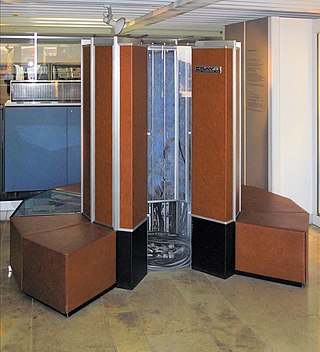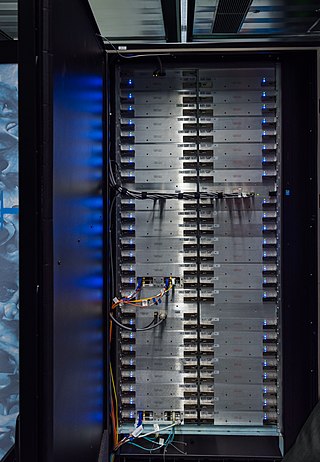
A supercomputer is a computer with a high level of performance as compared to a general-purpose computer. The performance of a supercomputer is commonly measured in floating-point operations per second (FLOPS) instead of million instructions per second (MIPS). Since 2017, supercomputers have existed which can perform over 1017 FLOPS (a hundred quadrillion FLOPS, 100 petaFLOPS or 100 PFLOPS). For comparison, a desktop computer has performance in the range of hundreds of gigaFLOPS (1011) to tens of teraFLOPS (1013). Since November 2017, all of the world's fastest 500 supercomputers run on Linux-based operating systems. Additional research is being conducted in the United States, the European Union, Taiwan, Japan, and China to build faster, more powerful and technologically superior exascale supercomputers.
In computing, floating point operations per second is a measure of computer performance, useful in fields of scientific computations that require floating-point calculations. For such cases, it is a more accurate measure than measuring instructions per second.

Blue Gene was an IBM project aimed at designing supercomputers that can reach operating speeds in the petaFLOPS (PFLOPS) range, with low power consumption.

The Pentium Pro is a sixth-generation x86 microprocessor developed and manufactured by Intel and introduced on November 1, 1995. It introduced the P6 microarchitecture and was originally intended to replace the original Pentium in a full range of applications. While the Pentium and Pentium MMX had 3.1 and 4.5 million transistors, respectively, the Pentium Pro contained 5.5 million transistors. Later, it was reduced to a more narrow role as a server and high-end desktop processor and was used in supercomputers like ASCI Red, the first computer to reach the trillion floating point operations per second (teraFLOPS) performance mark in 1996. The Pentium Pro was capable of both dual- and quad-processor configurations. It only came in one form factor, the relatively large rectangular Socket 8. The Pentium Pro was succeeded by the Pentium II Xeon in 1998.

The Advanced Simulation and Computing Program is a super-computing program run by the National Nuclear Security Administration, in order to simulate, test, and maintain the United States nuclear stockpile. The program was created in 1995 in order to support the Stockpile Stewardship Program. The goal of the initiative is to extend the lifetime of the current aging stockpile.
SUNMOS is an operating system jointly developed by Sandia National Laboratories and the Computer Science Department at the University of New Mexico. The goal of the project, started in 1991, is to develop a highly portable, yet efficient, operating system for massively parallel-distributed memory systems.

Scalable POWERparallel (SP) is a series of supercomputers from IBM. SP systems were part of the IBM RISC System/6000 (RS/6000) family, and were also called the RS/6000 SP. The first model, the SP1, was introduced in February 1993, and new models were introduced throughout the 1990s until the RS/6000 was succeeded by eServer pSeries in October 2000. The SP is a distributed memory system, consisting of multiple RS/6000-based nodes interconnected by an IBM-proprietary switch called the High Performance Switch (HPS). The nodes are clustered using software called PSSP, which is mainly written in Perl.
Red Storm is a supercomputer architecture designed for the US Department of Energy’s National Nuclear Security Administration Advanced Simulation and Computing Program. Cray, Inc developed it based on the contracted architectural specifications provided by Sandia National Laboratories. The architecture was later commercially produced as the Cray XT3.

The Cray XT3 is a distributed memory massively parallel MIMD supercomputer designed by Cray Inc. with Sandia National Laboratories under the codename Red Storm. Cray turned the design into a commercial product in 2004. The XT3 derives much of its architecture from the previous Cray T3E system, and also from the Intel ASCI Red supercomputer.

The TOP500 project ranks and details the 500 most powerful non-distributed computer systems in the world. The project was started in 1993 and publishes an updated list of the supercomputers twice a year. The first of these updates always coincides with the International Supercomputing Conference in June, and the second is presented at the ACM/IEEE Supercomputing Conference in November. The project aims to provide a reliable basis for tracking and detecting trends in high-performance computing and bases rankings on HPL benchmarks, a portable implementation of the high-performance LINPACK benchmark written in Fortran for distributed-memory computers.
The QCDOC is a supercomputer technology focusing on using relatively cheap low power processing elements to produce a massively parallel machine. The machine is custom-made to solve small but extremely demanding problems in the fields of quantum physics.
The National Center for Computational Sciences (NCCS) is a United States Department of Energy (DOE) Leadership Computing Facility that houses the Oak Ridge Leadership Computing Facility (OLCF), a DOE Office of Science User Facility charged with helping researchers solve challenging scientific problems of global interest with a combination of leading high-performance computing (HPC) resources and international expertise in scientific computing.
Portals is a low-level network API for high-performance networking on high-performance computing systems developed by Sandia National Laboratories and the University of New Mexico. Portals is currently the lowest-level network programming interface on the commercially successful XT line of supercomputers from Cray.
A lightweight kernel (LWK) operating system is one used in a large computer with many processor cores, termed a parallel computer.
New York Blue is an 18 rack Blue Gene/L and a 2 rack Blue Gene/P massively parallel supercomputer based on the IBM system-on-chip technology. It is located in the New York Center for Computational Sciences (NYCCS). The supercomputer is owned by Stony Brook University and is located at Brookhaven National Laboratory in Upton, Long Island, New York. The funds for this machine were provided by the New York state, with the leadership of the NYS Assembly. It began operating on July 15, 2007, when it was the fifth most powerful supercomputer dedicated to general research. According to Stony Brook provost Robert McGrath, it would also rank within the top 10 when including supercomputers available only for military research. The renovation of laboratory space was supported by the New York state and U.S. DOE fund. As of June 2010, the Blue Gene/L was ranked 67th in the Top 500 supercomputing rankings. Together with the Computational Center for Nanotechnology Innovations at Rensselaer Polytechnic Institute, New York Blue provides New York state with more computing power available for general research than any state in the nation.

Japan operates a number of centers for supercomputing which hold world records in speed, with the K computer becoming the world's fastest in June 2011. and Fugaku took the lead in June 2020, and furthered it, as of November 2020, to 3 times faster than number two computer.

The term supercomputing arose in the late 1920s in the United States in response to the IBM tabulators at Columbia University. The CDC 6600, released in 1964, is sometimes considered the first supercomputer. However, some earlier computers were considered supercomputers for their day such as the 1954 IBM NORC in the 1950s, and in the early 1960s, the UNIVAC LARC (1960), the IBM 7030 Stretch (1962), and the Manchester Atlas (1962), all of which were of comparable power.

Several centers for supercomputing exist across Europe, and distributed access to them is coordinated by European initiatives to facilitate high-performance computing. One such initiative, the HPC Europa project, fits within the Distributed European Infrastructure for Supercomputing Applications (DEISA), which was formed in 2002 as a consortium of eleven supercomputing centers from seven European countries. Operating within the CORDIS framework, HPC Europa aims to provide access to supercomputers across Europe.

Xeon Phi was a series of x86 manycore processors designed and made by Intel. It was intended for use in supercomputers, servers, and high-end workstations. Its architecture allowed use of standard programming languages and application programming interfaces (APIs) such as OpenMP.

The Cray XC40 is a massively parallel multiprocessor supercomputer manufactured by Cray. It consists of Intel Haswell Xeon processors, with optional Nvidia Tesla or Intel Xeon Phi accelerators, connected together by Cray's proprietary "Aries" interconnect, stored in air-cooled or liquid-cooled cabinets. The XC series supercomputers are available with the Cray DataWarp applications I/O accelerator technology.











